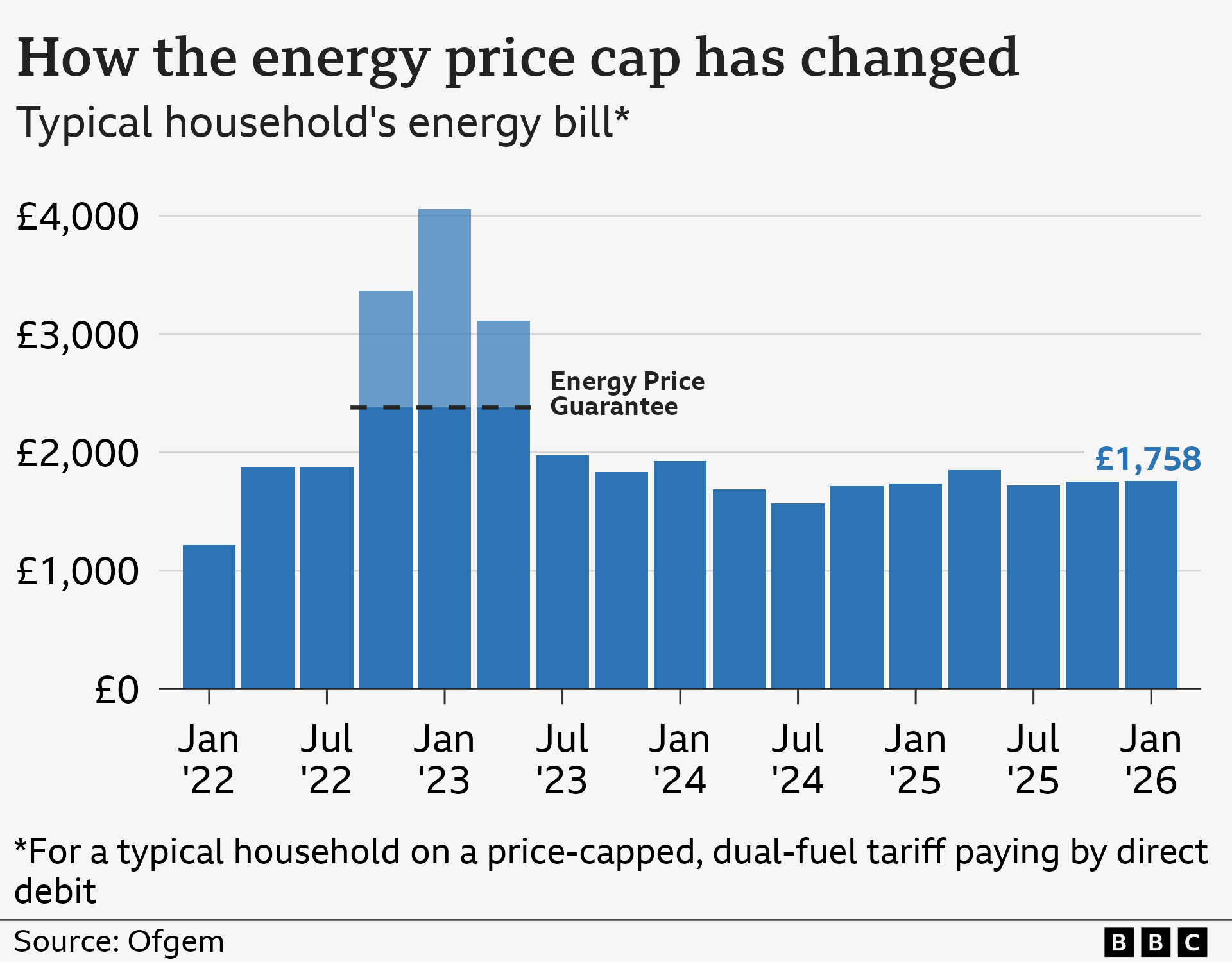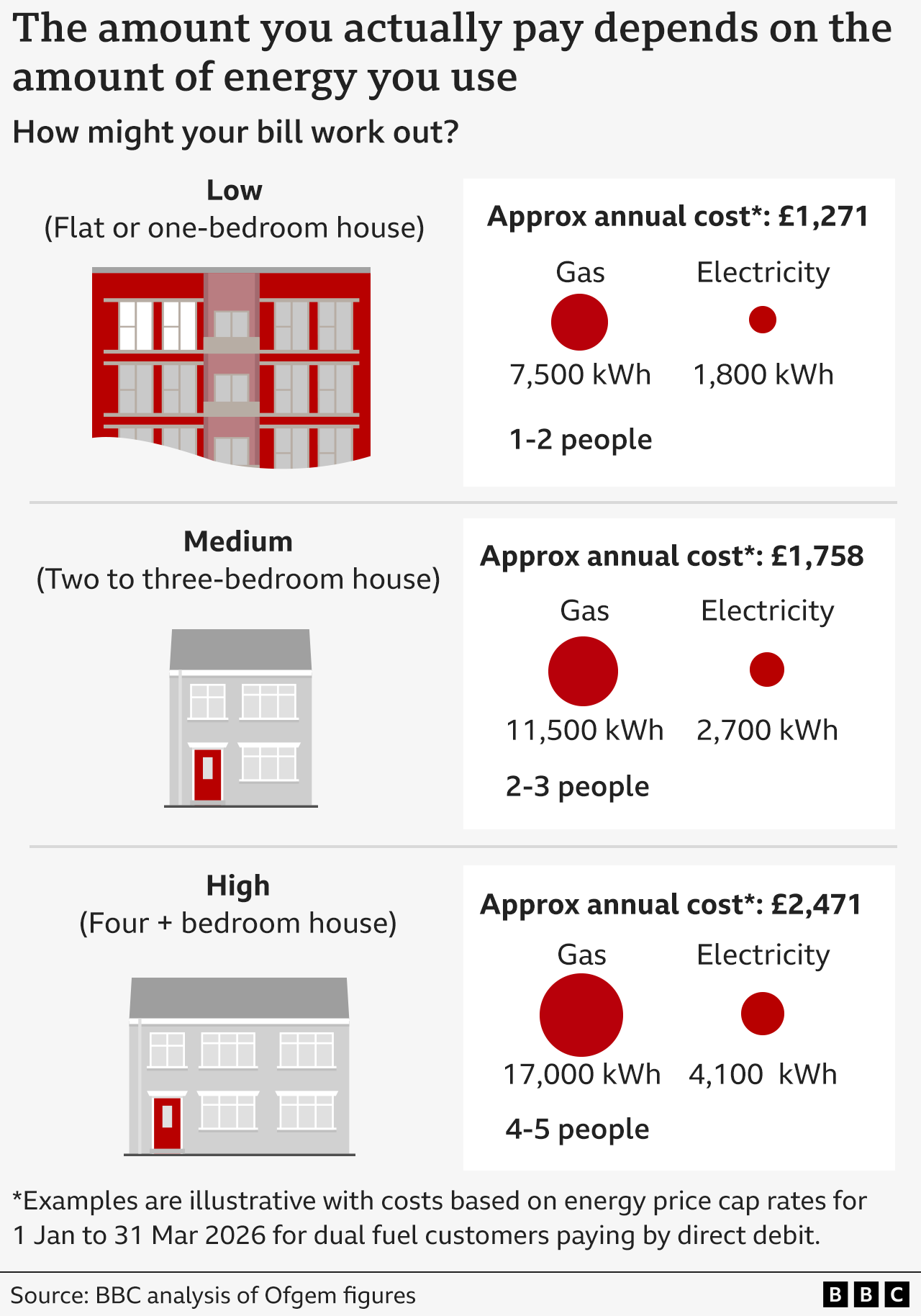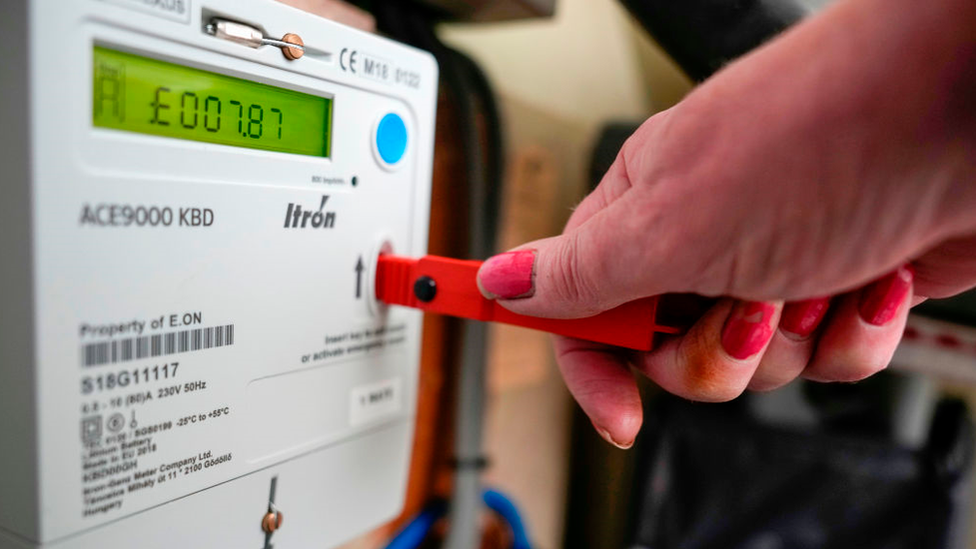What is happening to gas and electricity prices?

- Published
Typical gas and electricity bills will rise slightly in January, when the new price cap is introduced.
But, from April, average household energy bills are predicted to fall by £150 a year, under measures announced in the Budget.
How does the Budget change energy bills?
In the Budget, Chancellor Rachel Reeves said higher energy bills were "one of the greatest drivers of the rising cost of living".
She announced measures that should mean the price cap from April 2026 will be lower than previously thought.
Currently, energy bills in England, Scotland and Wales include charges that customers pay to help fund insulating homes of low-income people and subsidising green energy projects such as wind farms and solar panels.
The insulation scheme, called the Energy Company Obligation, will be scrapped and older renewable energy projects will be 75% funded by general taxation instead of a levy on energy bills, for three years.
The chancellor said the measures will take £150 off average annual dual-fuel bills.
Separately, it was previously announced that the Warm Homes Discount is being extended to cover six million homes, which will take £150 off energy bills for anybody on a means-tested benefit.
What is the energy price cap and how is it changing in January?
The energy price cap sets the maximum amount customers can be charged for each unit of gas and electricity, but actual bills depend on the amount used.
The energy price cap covers around 19 million households in England, Wales and Scotland and is set every three months, external by the energy regulator Ofgem.
It fixes the maximum price that can be charged for each unit of energy on a standard - or default - variable tariff for a typical dual-fuel household which pays by direct debit.
Between 1 January and 31 March 2026, the annual bill for a dual-fuel direct debit household using a typical amount of energy is £1,758, up £3 a year from the previous cap which applied between October and December.
During the three-month period, gas prices are capped at 5.93p per kilowatt hour (kWh) and electricity at 27.69p per kWh.
The cap does not apply in Northern Ireland, which has its own energy market.

What is a typical household?
Your energy bill depends on the overall amount of gas and electricity you use, and how you pay for it.
The type of property you live in, how energy efficient it is, how many people live there and the weather all make a difference.

The Ofgem cap is based on a "typical household" using 11,500 kWh of gas and 2,700 kWh of electricity a year with a single bill for gas and electricity, settled by direct debit.
The vast majority of people pay their bill this way to help spread payments across the year. Those who pay every three months by cash or cheque are charged more.
Energy price rises prompt call for more help with bills
- Published1 October
Customers' debt to energy suppliers soars to £4.4bn
- Published25 September
Four ways to keep your energy bills down
- Published27 August
Should I take a meter reading when the energy cap changes?
Submitting a meter reading when the cap changes means you are not charged for estimated usage at the wrong rate.
This is especially important when prices go up.
Customers with working smart meters do not need to submit a reading as their bill is calculated automatically.
What is happening to prepayment customers?
About six million households have prepayment meters, according to the latest Ofgem figures.
Prepayment customers were previously charged more than those who settle their bill by direct debit, but now pay slightly less.
Between 1 January and 31 March 2026, the typical annual bill for prepayment customers is £1,711.

Many pre-payment meters have been in place for years, but some were installed more recently after customers struggled to pay higher bills.
Rules introduced in November 2023, external mean suppliers must give customers more opportunity to clear their debts before switching them to a meter. They cannot be installed at all in certain households.
Can I fix my energy prices?
Fixed-price deals are not affected by the energy price cap, which changes every three months and can rise and fall.
They offer certainty for a set period - often a year, or longer - but if energy prices drop when you are on the deal, you could be stuck at a higher price. You may also have to pay a penalty to leave a fixed deal early if you change your mind.
Ofgem, the energy regulator, says customers who want the security of knowing what their bill will be should consider moving to a fixed deal. However, it says they should make sure they understand all the costs.
Martin Lewis, founder of Money Saving Expert, recommends checking whole-of-market energy price comparison sites to help find the best deal.
What are standing charges and how are they changing?
Ofgem also controls standing charges, which are a fixed daily fee to cover the costs of connecting households to gas and electricity supplies. These vary slightly by region, external.
Between 1 January and 31 March 2026, standing charges will typically be 55.75p a day for electricity and 35.09p a day for gas.
Campaigners have long argued that standing charges are unfair because they make up a bigger proportion of the bill of low energy users.
In response, Ofgem said that by the end of January 2026, it wants all energy firms to offer at least one tariff that has a low standing charge but higher cost per unit of energy.
The regulator said this would give some customers more choice and control, but acknowledged it would not be suitable for everyone.
Charities, campaigners and the suppliers' trade body criticised the proposal for just shifting the cost from one part of the bill to another rather than cutting it.
What help can I get with energy bills?
Figures from Ofgem show the level of energy debt and arrears in England, Wales and Scotland between April and June 2025 was £750m higher than in the same period in 2024.
The data also showed that more than one million households had no arrangement to repay their debt, another record high.
Suppliers must offer customers affordable payment plans or repayment holidays if necessary. Most also offer hardship grants.
Under plans Ofgem hopes to introduce in early 2026, nearly 200,000 people on benefits could have their debts to their energy supplier cancelled - as long as they have made some effort to pay what is owed.
The scheme could see up to £500m knocked off the £4.4bn currently owed to suppliers. But covering the cost will require an extra £5 being added to everyone's gas and electricity bill.
A number of existing government schemes also help people on low incomes with their energy bills.
The Household Support Fund, external, which was introduced in September 2021 to help vulnerable customers, has been extended until March 2026.
The Warm Home Discount scheme, external is also being overhauled. From winter 2025, anyone on means-tested benefits in Great Britain will get £150 taken off their bills, no matter what size of property they live in. The discount will be applied automatically for people in England or Wales, external and some in Scotland. However, those on a low income in Scotland will need to apply via their energy supplier. Letters are being sent to people with information on the discount.
The Fuel Direct Scheme, external lets people repay an energy debt directly from their benefit payments.
About nine million pensioners will also get the Winter Fuel Payment in 2025/2026, worth £200 or £300, after a government U-turn over eligibility.
Get in touch
How are you managing with the rising cost of living as a consumer or as a business owner? Share your experiences.